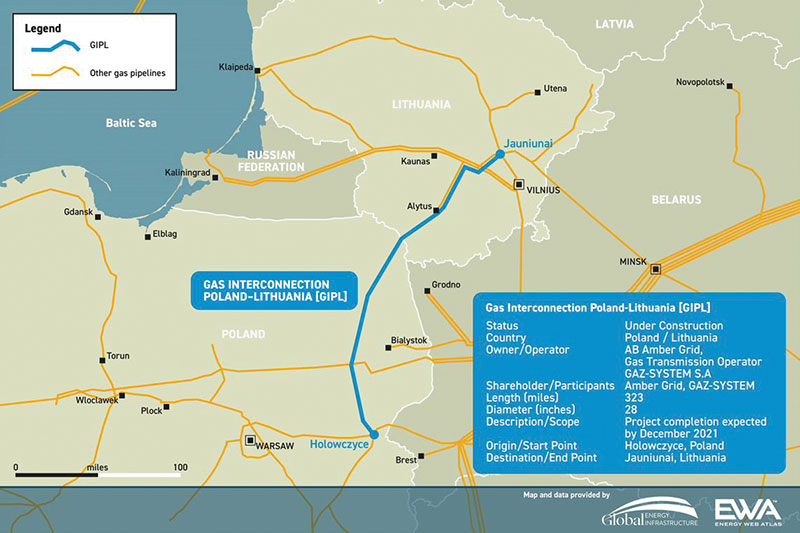June 2022, Vol. 249, No. 6
Features
Gas Interconnection Poland–Lithuania Pipeline Project Completed
By Mary Holcomb, Digital Editor
Construction of the 315-mile (508-km) Gas Interconnection Poland–Lithuania (GIPL) pipeline has been completed, and partial capacity will be available beginning May 1, according to operator Amber Grid Corp.
The pipeline is estimated to have a maximum potential capacity to ship 85 Bcf (2.4 Bcm) of gas annually in both directions, and a maximum potential capacity of 67 Bcf (1.9 Bcm) annually from Lithuania to Poland.
“As of May 1, we will be able to exchange natural gas with Europe via the GIPL gas interconnection between Lithuania and Poland,” said Nemunas Biknius, CEO of Amber Grid. “This important and previously planned step let us achieve the goal of the strategic infrastructure GIPL project – to open a new, alternative source of gas transportation to the region.”
The 27.5-inch, high-pressure pipeline successfully established a bidirectional gas transmission link between the two European countries. It will run from the Rembelszczyzna Gas Compressor Station in Warsaw, Poland, and travel to the Jauniunai Gas Compressor Station near Vilnius in Lithuania.
With the completion of GIPL, Lithuania, together with the other two Baltic states, and Finland will be integrated into the European Union (EU) gas transmission system.
For Poland, the GIPL project will allow the country to boost liquified natural gas (LNG) imports and ship gas to the Baltic states to smooth out any interruptions caused by the Russia-Ukraine war.
“In the context of today’s geopolitical tensions, the integration of the Baltic and Finnish markets into the common European gas market is a guarantee of energy security and independence for the entire region,” Lithuanian Energy Minister Dainius Kreivys said. “More gas supply sources give us more flexibility in ensuring the security and reliability of gas supply and will open more opportunities for the Klaipėda LNG terminal.”
Plans for the pipeline project kicked off in 2009, and construction officially began in February 2020 when the pipeline’s route was marked, and other necessary safety protocols were conducted for the start of construction.
One major issue during the construction process involved the assembling of two 750-meter (2,460-foot) threads of gas transmission systems under Nemunas, the second biggest river in Lithuania, according to Amber Grid.
However, it was resolved by deploying an environmentally sustainable horizontal directional drilling technology without delay. The two 750-meter pipes were laid side by side to ensure a secure gas supply.
“The GIPL gas interconnection is one of the most important strategic energy projects, the importance of which has grown even more in the context of recent geopolitical events and the war in Ukraine,” Biknius said. “Since the very beginning of the GIPL project, special attention has been paid to the selection of project contractors, quality assurance of works and equipment and the timely construction of the pipeline.”
The European Commission has recognized the GIPL project as a major infrastructure gas supply security contributing significantly to the EU’s energy security.







Comments